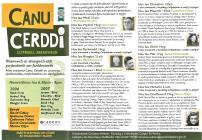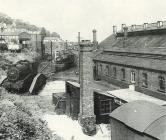Content can be downloaded for non-commercial purposes, such as for personal use or in educational resources.
For commercial purposes please contact the copyright holder directly.
Read more about the The Creative Archive Licence.
Description
Lede
“TRAGEDY OF THE SEA” read the headline in North Pembrokeshire’s local newspaper, The County Echo, when it reported the destruction by enemy action of the Fishguard to Rosslare passenger and mail ferry the St Patrick with the loss of 28 lives.
Story
The St Patrick was the only ferry still sailing between Ireland and Wales during World War Two. The others, the St David and the St Andrew, had been requisitioned as hospital ships serving the European front. The St. Patrick made a regular daily crossing of St. George’s Channel, protected from submarine attack by an extensive minefield to the south. The ship had however been twice strafed from the air and the previous year a Wexford sailor, Moses Brennan, had died following a machine gun wound.
Some of those who boarded in Wexford on the night of Friday June 13th, 1941 might have considered the date inauspicious, but the sea was calm and the ship was in the experienced hands of Captain Jim Faraday who expected to reach his home port of Fishguard soon after sunrise. Unusually, he had his Merchant Navy cadet son Jack with him ‘for the ride’ since he happened to be home on leave. The captain, like most of the crew, was a local man, but five were Irish, as were most of the passengers.
Twelve miles off Strumble Head, just as the summer dawn was breaking, the ship was targeted by a German Heinkel aeroplane which dropped a stick of four bombs amidships, destroying the saloon cabin and the bridge and igniting the fuel tanks. All but one of the first class passengers died instantly as did the captain and his senior officers. The burning ship broke in two and sank in minutes. The surviving crew launched a lifeboat and a raft and did their utmost to save the remaining 43 passengers most of whom were floundering in the oily water.
Of the two stewardesses, one had been killed outright, leaving only 41-year-old May Owen to evacuate the women and children. May refused to leave the sinking ship until all her charges were in life jackets, and even at the last moment she went below again to assist a passenger. She then supported a woman and a girl in the water for two hours before being picked up by a rescue vessel.
Second engineer Frank Purcell bravely went down into the burning ship to save three men trapped in the engine room. He found a fourth lying injured in a passageway, brought him on deck and supported him in the water until they could be rescued.
The radio operator, Norman Campbell, remained at his post below decks until the bitter end using emergency equipment to signal for help. As a result of his courage and presence of mind he was able to alert nearby ships, which raced to the scene. The surviving passengers and crew were plucked from the sea and taken to Milford Haven. By the time the Fishguard lifeboat reached the spot nothing was visible apart from a couple of fish boxes floating among the bubbles.
These three crew members, all residents of Fishguard and Goodwick, were later honoured for their courage. Frank Purcell and Norman Campbell received the Order of the British Empire while May Owen was awarded the George Medal for gallantry. She returned to work as a stewardess and lived out her life quietly, with few knowing of her heroism. She married but had no children, and is buried in a peaceful windswept cemetery high above her home town within sight of the sea and of Strumble Head, not so far from where the St Patrick lies on the seabed. The small initials G.M. after her name are barely noticeable.
By strange coincidence, two parallel father-son tragedies are associated with the loss of the St Patrick, mirroring one another across the water as if to highlight the fragility of sea-going lives.
Captain Faraday’s 19-year-old son Jack, although not officially a crew member, was a strong swimmer and worked tirelessly to rescue people from the water but, finding his father not among them, went back to look for him. He was not seen again. His brother later joined the air force to seek vengeance and also lost his life.
The youngest crew member on the St Patrick, deck boy Michael John Brennan, aged 17, was the son of the Wexford sailor who died from injuries received in the previous enemy attack on the ship. The eldest of Moses Brennan’s seven children, John had gone to sea to support his family after his father’s death.
Following the sinking of the St Patrick, the close-knit communities of Wexford and Fishguard/Goodwick shared the pain of a loss that rippled out and touched so many in those wartime years – and which is not forgotten even now. Every Remembrance Day the current ferry pauses in its crossing and drops a wreath at the spot where the St Patrick went down.
Factoid
Strumble Head is on the Pembrokeshire Coast Path and it is about a six mile walk between and Goodwick.





Do you have information to add to this item? Please leave a comment
Comments (0)
You must be logged in to leave a comment